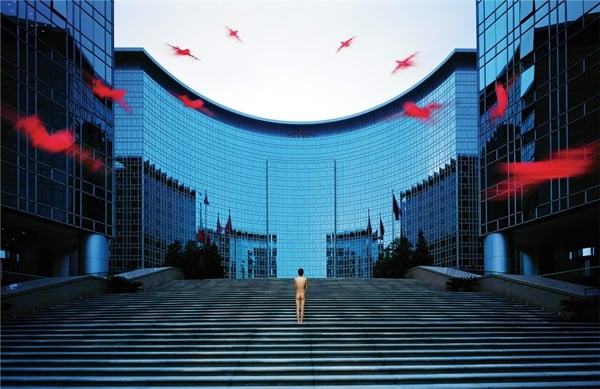
Mao Tse-tung died in 1976, but that is where “My Generation: Young Chinese Artists” begins. The large, just-opened exhibition in the improbable location of northwest Florida looks at work by artists born after Mao’s death, during China’s “one child” policy, and amidst the nation’s unprecedented economic and technological boom.
“I wondered,” asks the show’s curator, Barbara Pollack, “What kind of art would people make who went through that upheaval?”
The answer has produced an uneven but intriguing exhibition featuring two host institutions, a brush with censorship, and maybe even a bit of a political agenda of its own—at least when it comes to the sponsor, Merrill Lynch.
“My Generation” is showing now through September at both the Tampa Museum of Art and The St. Petersburg Museum of Fine Arts, which are roughly 25 minutes and a bay apart. Curiously, museum officials say, the exhibition agenda isn’t principally to pull in a specific demographic of the local community, as some shows that focus on the art of a particular nation try to do. The ambitious bet was more that the show, if picked up elsewhere (Oklahoma City Museum of Art signed on recently and other institutions are in talks) might prove buzzy, even influential, and bring attention to the growing region and its culture.
Meanwhile, Merrill Lynch, which operates five offices in the Tampa–St. Pete region, picked up much of the cost of the bifurcated show with a six-figure gift, just after a broad expansion of its own banking services within mainland China. For most of the young Chinese artists, this is the first time their work has been shown in the US.
But it is a market-savvy show: Far from being emerging or obscure, these 27 young artists have already been exhibited internationally, had their works offered at art fairs, and have powerhouse galleries like James Cohan and Sean Kelly behind them. Somewhat unfortunately, the opening room of the St. Pete wing of the exhibition comes from the Armory art fair. Video works are quite plentiful and topics addressed include politics, the environment, and personal issues. The artists’ influences were not so much Chinese scroll painting as Martin Kippenberger and Marcel Duchamp.
“It’s as if they grew up in two different countries in two different centuries,” from their immediate predecessors such as Ai Weiwei, says Pollack.
A trio of the artists in the show attended the opening, and spoke to unexpectedly large and energetic crowds. Questions addressed their home nation’s reputation for surveillance and censorship. Explained artist Jin Shun: “Google anything about the leaders of China and it is censored, and you can’t use [the Internet] again for five minutes.” In China, the policy is called the Great FireWall.
Lu Yang, video still from Wrathful King Kong Core (2011)
Photo: Courtesy St. Petersburg Museum of Fine Arts
In terms of censorship’s impact on the show, the Chinese government kept only one piece out of the US, notes Tampa Museum director Todd Smith, and it was a sexually explicit one. Similarly, an artwork of bullet-dotted glass, an insider reference to the Tiananmen Square massacre, was loaned by a US collector in the place of a similar work owned by a Chinese collector.
Sun Xun, who will live in the Sean Kelly gallery in December, decorating its walls as a performance installation, said that people of his generation in China were educated about the country’s recent history in school but “Every day, my father got drunk, a little bit, and told me what happened in the past; my grandmother too.” The three sources had “all different histories,” he noted.
Locals appeared fascinated to hear what it was like to grow up as an artist in China. Much like the country’s better known sports programs that identify would-be Olympic divers or gymnasts at a young age, artists are split out early on and funneled into arts programs as early as grade school.
The show came together almost by accident when Pollack met Tampa staff and director Todd Smith (he leaves this month to head the Orange County Museum of Art) at a dinner. He later joined her on a visit to China to visit dozens of young artists. Smith had long hoped to do a joint show with his friend and colleague Kent Lydecker, director of the St. Petersburg institution, and they teamed on the China show. Lydecker, a transplant from the Metropolitan Museum of Art, he says the show was a way to bridge the museum’s encyclopedic holdings of ancient art with the present and bring attention to his institution’s growth in advance of its 50th anniversary in 2015.
Overall, what Pollack found was artists who wanted to do political art—obliquely—and dealt with issues of religion and the urbanized landscape and who, she says, “are rebelling against the thought that Chinese art has to look Chinese.”
Huang Ran, video still from Disruptive Desires, Tranquility and the Loss of Lucidity (2012)
Photo: Courtesy Long March Space, Beijing.